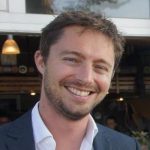Searching for litter in Walrus Bay
This morning we spotted Jan Mayen, our first call on this expedition. Jan Mayen is a volcanic island in the middle of the North Atlantic Ocean, between Iceland, Greenland and Spitsbergen. It is a spectacular island, 55 km long, spoon-shaped. With the huge Beerenberg volcano at its north-eastern end. This is the most northern active volcano. Beerenberg (Bear Mountain) is the highest Norwegian mountain (almost 2300m high). Unfortunately, today the summit is shrouded in clouds and Beerenberg refuses to reveal itself.
Ortelius is anchored in Båtvika (Boat Bay). Here we make a safe landing on the black lava beach, where the Station Commander, Tore Arnesen Wensel, welcomes the passengers. After a general talk about the island, most passengers take a walk across the island. Meanwhile, Tore takes us in one of the station’s jeeps to some remote beaches such as the North Laguna, to check out the beach litter.
Litter monitoring at Jan Mayen
After this we drive to Kvalrossbukta (Walrus Bay) to start our beach litter monitoring. The first ever on Jan Mayen utilising the OSPAR Marine Litter Monitoring guideline. The beach is littered with tree trunks. In between lie scattered remains of whale bones from the whaling ages: large parts of skulls, huge ribs etcetera. In the 17th century the Dutch whalers decimated the Bowhead Whale population around the island within a few decades.
We mark a stretch of 100 meters on the beach and start monitoring, ticking off each bit of litter on the OSPAR marine litter survey list, which contains more than 200 different items. After about 1½ hours the first hikers arrive on the beach and some passengers spontaneously decide to give us a hand gathering and counting the debris. This turns out to be a fairly large amount: on this beach we count 501 pieces of litter.
Mostly fishery litter
With 114 pieces, the category ‘plastic pieces’ is the largest. Of the recognisable debris, a lot is clearly from the fishery industry: 104 floats or pieces of floats, bits of net (26), tangled nets (20) and ropes (43). Plastic bottles (11) and caps (28) also stand out.

Absence of food packaging items
To get a perspective on the monitoring results of Jan Mayen we compare these to the situation in the Netherlands. In the Netherlands, the average amount of litter items on a 100m stretch of beach is 395 items; at Kvalrossbukta we found 501 pieces. What is most striking at Jan Mayen is the amount of floats which are used in the fisheries: where on average less than one float is found in the Netherlands, we found 104 on this beach in Jan Mayen. Another considerable difference with the Netherlands is the almost total absence of food packaging items. In short, it is clear that at Jan Mayen the most important sources of litter are fisheries and shipping. To find out more about the exact type of fisheries responsible for the nets we found on the beach, we take some pieces home for further analysis.
While counting the type and number of items on the beach we also found some remarkable items, such as a miniature toy cruise liner made from plastic and… a human tooth – could it be from a Dutch whaler who died of scurvy?
We write a short story about our monitoring in the guestbook at the cabin on the beach. As a thank you to the station commander and his team, we present him with a bottle of Corenwijn and several pairs of Healthy Seas socks, made from recycled fishing nets. After the anchor is raised, we sail along the coast of Jan Mayen underneath Mount Beerenberg and then head for our next destination: Svalbard.
At Svalbard, we will try to monitor several more beaches. We are keen on finding out the similarities and differences with Jan Mayen.
The expedition and the blog Arctic Marine Litter is a collaboration between Wouter Jan Strietman and Eelco Leemans
More information about this expedition
- 1 The Arctic Marine Litter expedition has begun!
- 2 Searching for litter in Walrus Bay
- 3 The Drain of the Gulfstream
- 4 What are the origins of the beach litter?


[…] Blog 2 “Searching for litter in Walrus Bay“ […]